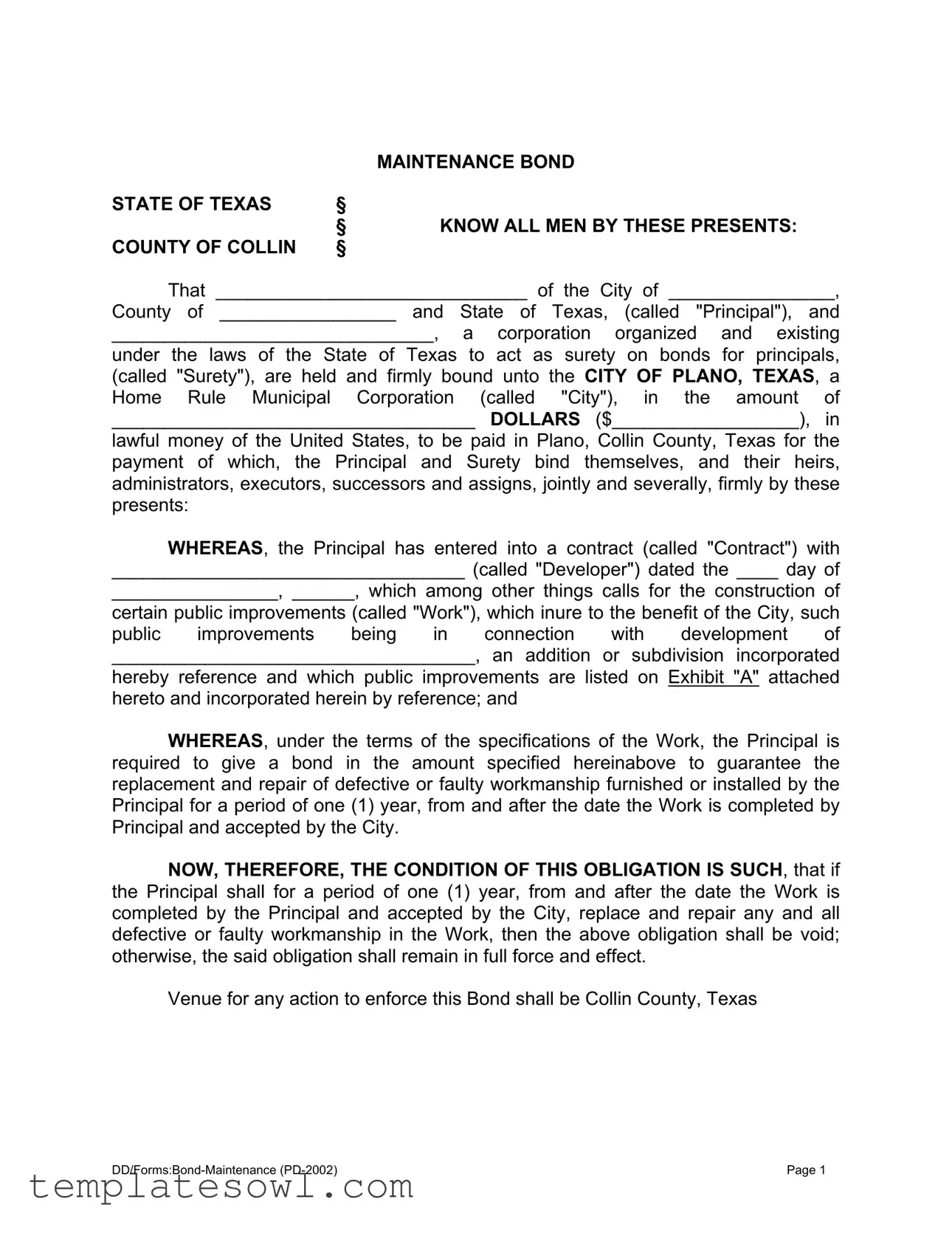|
|
MAINTENANCE BOND |
STATE OF TEXAS |
§ |
|
|
§ |
KNOW ALL MEN BY THESE PRESENTS: |
COUNTY OF COLLIN |
§ |
|
That ______________________________ of the City of ________________,
County of _________________ and State of Texas, (called "Principal"), and
_______________________________, a corporation organized and existing
under the laws of the State of Texas to act as surety on bonds for principals, (called "Surety"), are held and firmly bound unto the CITY OF PLANO, TEXAS, a Home Rule Municipal Corporation (called "City"), in the amount of
___________________________________ DOLLARS ($__________________), in
lawful money of the United States, to be paid in Plano, Collin County, Texas for the payment of which, the Principal and Surety bind themselves, and their heirs, administrators, executors, successors and assigns, jointly and severally, firmly by these presents:
WHEREAS, the Principal has entered into a contract (called "Contract") with
__________________________________ (called "Developer") dated the ____ day of
________________, ______, which among other things calls for the construction of
certain public improvements (called "Work"), which inure to the benefit of the City, such public improvements being in connection with development of
___________________________________, an addition or subdivision incorporated
hereby reference and which public improvements are listed on Exhibit "A" attached hereto and incorporated herein by reference; and
WHEREAS, under the terms of the specifications of the Work, the Principal is required to give a bond in the amount specified hereinabove to guarantee the replacement and repair of defective or faulty workmanship furnished or installed by the Principal for a period of one (1) year, from and after the date the Work is completed by Principal and accepted by the City.
NOW, THEREFORE, THE CONDITION OF THIS OBLIGATION IS SUCH, that if the Principal shall for a period of one (1) year, from and after the date the Work is completed by the Principal and accepted by the City, replace and repair any and all defective or faulty workmanship in the Work, then the above obligation shall be void; otherwise, the said obligation shall remain in full force and effect.
Venue for any action to enforce this Bond shall be Collin County, Texas
DD/Forms:Bond-Maintenance (PD-2002) |
Page 1 |
IN WITNESS WHEREOF, the said Principal and Surety have signed and sealed this instrument this ____ day of ________________, ______.
|
Principal |
|
Surety |
By: |
______________________ |
By: |
______________________ |
Title: |
______________________ |
Title: |
______________________ |
Address: |
_______________________ |
Address: |
________________________ |
|
_______________________ |
|
________________________ |
|
_______________________ |
|
________________________ |
The name and address of the Resident Agent of Surety is:
Name: |
______________________________________________________ |
Address: |
______________________________________________________ |
City, State, Zip |
______________________________________________________ |
|
____________ |
For additional information on the above named Surety company you may contact the Texas Department of Insurance at (800)578-4677.
NOTE: Date on Page 1 of Maintenance Bond must be same date as Contract. Date on Page 2 of Maintenance Bond must be after the date of Contract. If Resident Agent is not a corporation, give a person's name.
DD/Forms:Bond-Maintenance (PD-2002) |
Page 2 |

